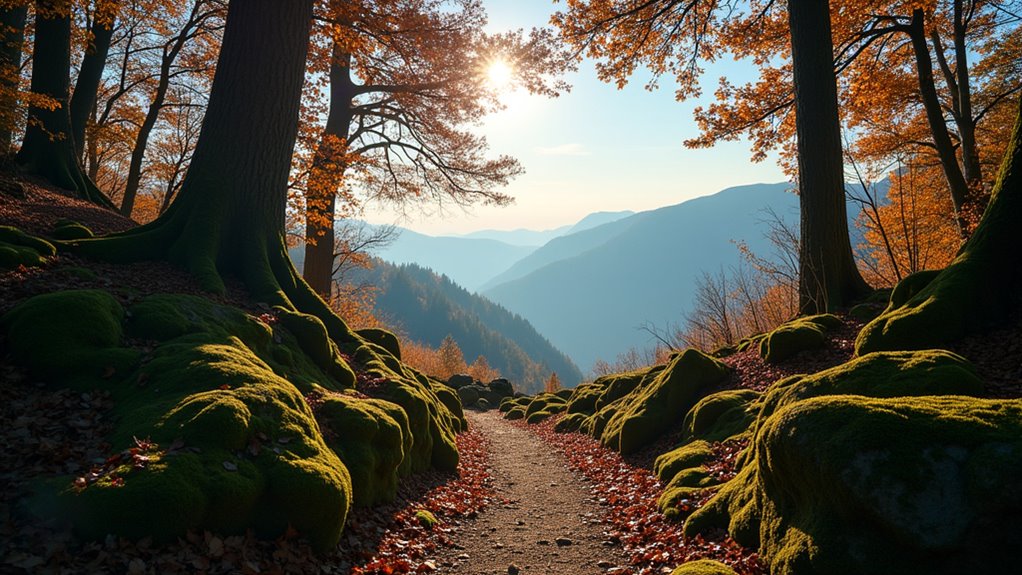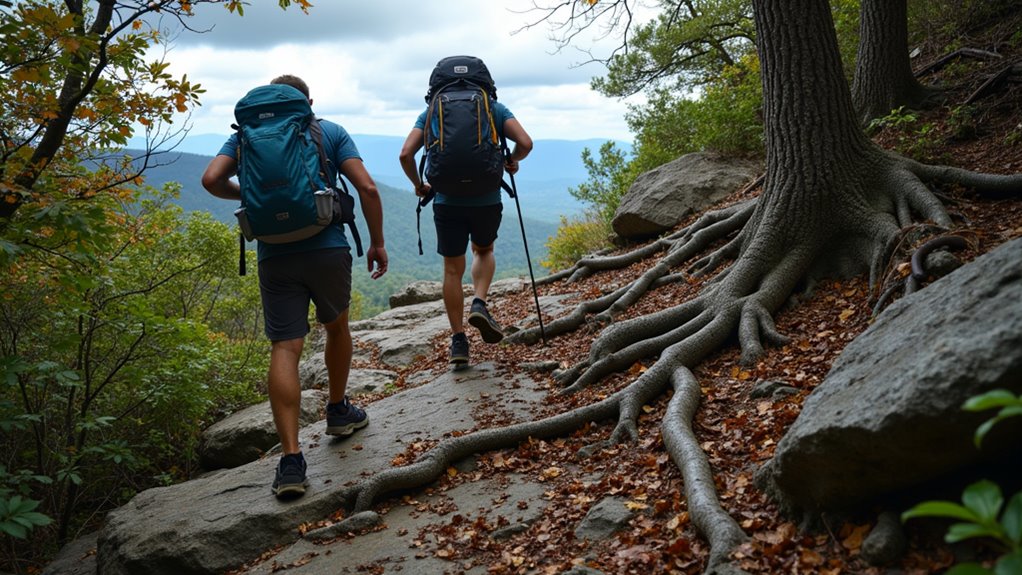Physical Address
304 North Cardinal St.
Dorchester Center, MA 02124
Physical Address
304 North Cardinal St.
Dorchester Center, MA 02124

Beyond its 2,200-mile wilderness journey, the Appalachian Trail beckons adventurers with transformative experiences and untold discoveries waiting around every bend.
You’ll find yourself standing at Springer Mountain in Georgia, where the legendary Appalachian Trail begins its 2,200-mile journey northward. Whether you’re planning a weekend trek or dreaming of joining the elite “thru-hikers,” this historic footpath offers more than just a walk in the woods. It’s transformed countless lives since its completion in 1937, and continues to challenge modern adventurers with its rugged terrain, unpredictable weather, and promise of discovery. Let’s explore what makes this iconic trail a life-changing experience.

When Benton MacKaye proposed his vision for the Appalachian Trail in 1921, he wasn’t just dreaming up a hiking path – he was launching an ambitious plan that would reshape America’s relationship with its eastern wilderness.
You’ll find MacKaye’s original concept went far beyond a simple footpath. He envisioned a rustic trail that would connect communities, preserve natural landscapes, and provide urban dwellers with a much-needed escape into nature.
While his vision faced challenges, including a notable clash with Myron Avery’s more pragmatic approach in 1935, the trail’s legacy has proven remarkably enduring. The Appalachian Trail Conference was established in 1925 under Major William Welch to help turn this ambitious vision into reality.
By 1937, you could hike the entire continuous path from Georgia to Maine.
Today, as America’s first national scenic trail, it serves as a reflection of MacKaye’s pioneering vision of combining conservation with outdoor recreation.
Taking on the Appalachian Trail requires thoughtful preparation, much like MacKaye’s original planning of the trail itself.
Like MacKaye’s pioneering vision, success on the Appalachian Trail demands careful forethought and meticulous planning from modern adventurers.
You’ll need to secure necessary permits and pay fees, particularly for areas like Shenandoah National Park. The AWOL Guide and AT Data Book will become your essential companions, providing vital details about shelters, water sources, and resupply points.
Be aware that Hurricane Helene‘s impact in 2024 has altered some trail sections in NC, TN, and SW VA. You should check the ATC website regularly for updates on closures and conditions. Most visitors choose to explore the trail through day hiking opportunities rather than attempting long-distance treks.
Whether you’re planning a thru-hike or day trips, remember to embrace Leave No Trace principles. Pack appropriate gear, study your route carefully, and stay flexible with your plans.
The trail’s ever-changing nature demands respect and adaptability from every hiker.

The physical demands of hiking the Appalachian Trail can’t be overstated, as you’ll face nearly half a million feet of elevation gain across its 2,200-mile journey.
You’re looking at four to six months of continuous hiking, where you’ll likely shed around 25 pounds while carrying a pack weighing 15-25 pounds, plus food and water.
The trail’s rugged terrain throws everything at you – from muddy paths and rocky scrambles to steep climbs through unpredictable weather conditions. Regular training includes rainy day hikes to prepare hikers for these challenging conditions.
You’ll navigate remote sections where careful planning is essential, and you’ll battle both physical and mental fatigue. The isolation and uncertainty can be as challenging as the physical demands. Winter camping can present additional challenges during the colder months.
It’s no wonder only 20-25% of hikers complete the trail, with the success rate dropping considerably among older adventurers.
Beyond the physical challenges of the Appalachian Trail lies a network of hidden treasures most hikers never discover.
You’ll find secluded spots like Jones Falls, where a cascading waterfall meets a perfect rock ledge for resting, and the invigorating Hertline Campsite swimming hole that’s ideal for cooling off. Accessing Jones Falls requires a short 0.1 mile blue blaze trek from the main trail.
History buffs won’t want to miss the Daicey Pond Library, a cozy cabin in Maine’s Baxter State Park, or the lesser-known trails of Harpers Ferry National Historical Park. Wildlife watching can be an enriching experience while camping along the Appalachian Trail.
Hidden gems for history lovers await at Daicey Pond Library and Harpers Ferry’s quiet trails, each telling stories of Appalachia’s rich past.
For spectacular views without the crowds, climb the Shuckstack Fire Tower or Mount Cammerer Lookout.
The trail’s unique features include its only paved section at Bear Mountain, complete with a zoo housing native wildlife, and the historic stone shelters that dot the southern states, offering both solitude and a glimpse into the AT’s past.

Kindness flows freely along the Appalachian Trail through dedicated individuals known as “trail angels” – volunteers who’ve shaped the hiking community for over 90 years.
You’ll find these generous souls offering unexpected “trail magic” in various forms: a cold drink on a hot day, a ride into town, or even a warm bed for the night.
Many trail angels are former hikers themselves, understanding exactly what you’ll need most during your journey. Leave No Trace principles are important to follow when interacting with strangers on the trail, even those offering assistance.
They’re not affiliated with any organization – they simply help because they want to share joy and build connections. While you shouldn’t rely on trail magic, these acts of kindness often appear when you’re facing your toughest moments on the trail.
Beyond the magic, trail angels also serve as essential stewards, maintaining paths and shelters that keep the 2,190-mile adventure possible.
You might think the Appalachian Trail’s length makes it an impossible dream, but you don’t have to tackle all 2,200 miles at once. Whether you’re hiking a weekend section or spending six months as a thru-hiker, you’ll discover why millions have fallen in love with America’s most famous footpath. From Georgia’s rolling hills to Maine’s rugged peaks, the AT’s calling your name – and it’s time to answer.